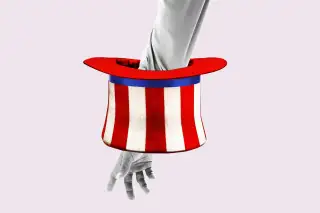Did You Apply for a Small Business Loan? Here's What to Know About the Latest Round of PPP Funding

The Paycheck Protection Program is (once again) up and running, as banks gained access on Monday to the new small business relief funds approved by lawmakers last week. Small business owners may have a difficult time getting a piece of the pie — but that doesn't mean you shouldn't try.
The Paycheck Protection Program was initially announced as part of the CARES Act in late March, when Congress set aside $349 billion in partially forgivable loans for banks to allocate to small businesses struggling to stay afloat amid the coronavirus crisis. But after the first round ran out within two weeks, lawmakers approved an additional $310 billion last Thursday.
That first round of funding only covered 20% of applicants, according to a survey conducted by the National Federation of Independent Business. And it turns out that the program wasn't exactly first come, first served, as the Treasury had said it would be — businesses with more resources were being favored over mom and pop shops, as banks prioritized bigger customers in an effort to maximize profit and minimize risk.
Many experts and businesses are wary that this time will be more of the same ...but additional measures from Congress and the Treasury could give smaller businesses better access to the second round of funding.
Here's what to know about the latest installment and what it could mean for your application.
I've already applied
There's no need for a re-do. Your application is already in the system, per language on many of the major banks' websites, and you can take some comfort in knowing the numbers could work out a little differently this time.
In theory, the additional $310 billion would cover even fewer businesses than the initial $349 billion — a concerning thought for the 80% of applicants still waiting for approval. But the new installment could go further: The first $349 billion was tapped into by multimillion dollar companies (including publicly traded ones), and these larger companies requested larger loans. The average loan for the first round wound up being around $206,000, according to the Small Business Administration.
This time around, "the average loan amount will be smaller, [and the] number of loans will probably be larger,” says Frank Knapp, the co-chair of Businesses for Responsible Tax Reform and President and CEO of the South Carolina Small Business Chamber of Commerce. “But will it take care of all of the demand in the business community? No.”
On Thursday, the Treasury took matters one step further by releasing additional guidance that makes it harder for companies with substantial resources to dip into the funds. It asks borrowers to certify “in good faith” that this loan request is necessary for their business to continue operating, according to a Q&A from the Treasury.
“Borrowers must make this certification in good faith, taking into account their current business activity and their ability to access other sources of liquidity sufficient to support their ongoing operations in a manner that is not significantly detrimental to the business,” reads the Q&A. “For example, it is unlikely that a public company with substantial market value and access to capital markets will be able to make the required certification in good faith, and such a company should be prepared to demonstrate to SBA, upon request, the basis for its certification.”
Borrowers have until May 7, 2020 to pay back any Paycheck Protection Program money they don't truly need, which means more money could flow back into the fund for hopeful applicants.
"If you have a loan that is already been deemed complete by your lender but simply was not funded due to the funding [permitted], you should be cautiously hopeful," says Gwendy Brown, Vice President of Research and Policy at Opportunity Fund, a nonprofit that focuses on providing financing to underserved small-business owners.
I haven’t submitted an application yet
If you haven’t yet submitted an application, you might be worried that yours will be placed behind the millions of others in the queue. But a provision of the funding makes it a little easier for the smallest companies to get ahead.
Of the $310 billion, $30 billion will go to financial institutions with $50 billion to $10 billion in assets, and $30 billion would go to those with less than $10 billion in assets, which means there's a total of $60 billion reserved specifically for banks catering to companies with fewer resources. By heading to a community bank or a smaller credit union instead of a large institution, smaller businesses can ensure that competition for their application is lower and chances of being processed are higher — like a ticket to a shorter, more accessible line.
“They now have the opportunity to go there and get a better response," says Knapp.
If you plan on banking with one of the larger banks, you should head to your bank's Paycheck Protection Program site to find out if your bank is currently taking applications (JP Morgan Chase indicated on its website that it isn't, while Wells Fargo says that it is). While a third installment to the Paycheck Protection Program has been discussed as unlikely, both Knapp and Brown's advice is to get on the list sooner rather than later — just in case.
Aside from the fact that it couldn't hurt to try, Brown adds that lots of unmet need could also help better inform future decisions on the Hill.
"It's important information for policy makers to have the amount of unmet demand at the end of this round," she says. "One way to measure that is certainly just the number of small businesses in America. But I think the number of businesses that are actually applying is also a very important data point."
More from Money:
Will the New Small Business Loan Package Actually Help Small Businesses This Time?